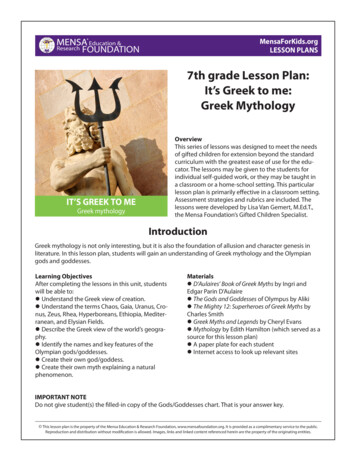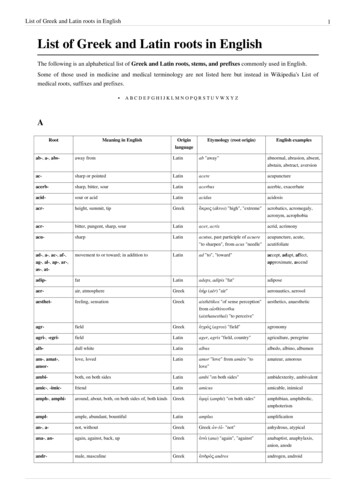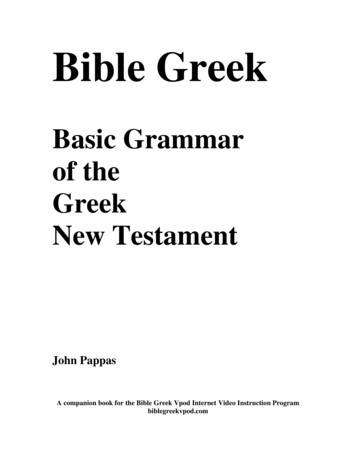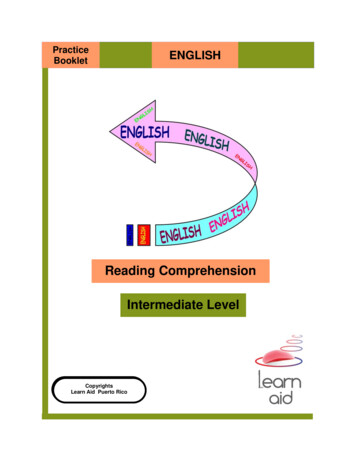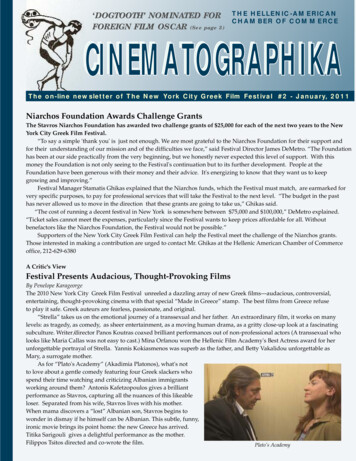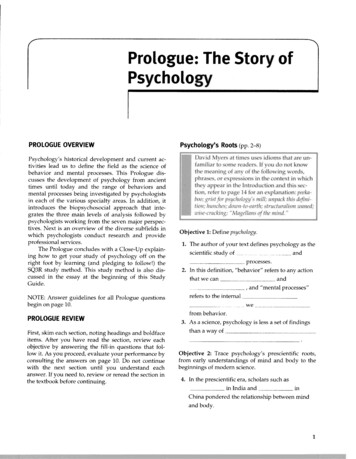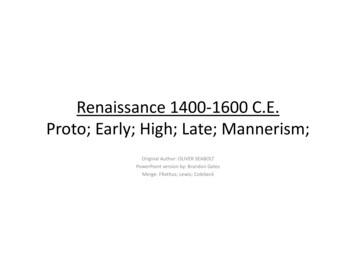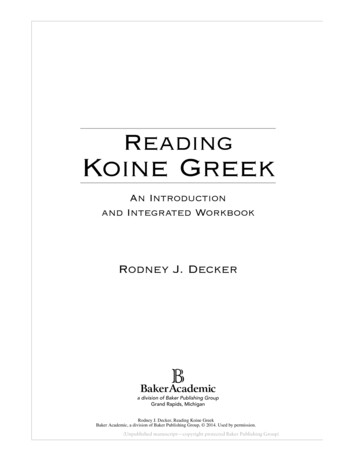
Transcription
ReadingKoine GreekAn Introductionand Integrated WorkbookRodney J. DeckerKRodney J. Decker, Reading Koine GreekBaker Academic, a division of Baker Publishing Group, 2014. Used by permission.(Unpublished manuscript—copyright protected Baker Publishing Group)Decker ReadingGreek WT bb.indd iii9/12/14 11:45 AM
2014 by Rodney J. DeckerPublished by Baker Academica division of Baker Publishing GroupP.O. Box 6287, Grand Rapids, MI 49516-6287www.bakeracademic.comPrinted in the United States of AmericaAll rights reserved. No part of this publication may be reproduced, stored in a retrieval system, or transmitted in any form or by any means—for example, electronic, photocopy, recording—without the priorwritten permission of the publisher. The only exception is brief quotations in printed reviews.Library of Congress Cataloging-in-Publication DataDecker, Rodney J., 1952–2014.Reading Koine Greek : an introduction and integrated workbook / Rodney J. Decker.pages ; cmIncludes bibliographical references and index.ISBN 978-0-8010-3928-7 (cloth)1. Greek language, Biblical—Grammar. 2. Greek language, Biblical—Grammar—Problems,exercises, etc. I. Title.PA817.D38 20142014013739487 .4—dc23Unless otherwise indicated, all Scripture quotations are the author’s translation.1415 16 171819 2076 54 32 1Rodney J. Decker, Reading Koine GreekBaker Academic, a division of Baker Publishing Group, 2014. Used by permission.(Unpublished manuscript—copyright protected Baker Publishing Group)Decker ReadingGreek WT bb.indd iv9/12/14 11:45 AM
To my Greek teachersRobert J. WilliamsWilliam E. Arp†Kenneth I. BrownW. Edward GlennyRodney J. Decker, Reading Koine GreekBaker Academic, a division of Baker Publishing Group, 2014. Used by permission.(Unpublished manuscript—copyright protected Baker Publishing Group)Decker ReadingGreek WT bb.indd v9/12/14 11:45 AM
Rodney J. Decker, Reading Koine GreekBaker Academic, a division of Baker Publishing Group, 2014. Used by permission.(Unpublished manuscript—copyright protected Baker Publishing Group)Decker ReadingGreek WT bb.indd vi9/12/14 11:45 AM
ContentsExpanded Table of Contents ixAcknowledgments xvPreface xixAbbreviations xxviiIntroduction: The Language of Koine Greek 18.19.20.AlphabetNouns: Part 1Nouns: Part 2Pronouns: Part 1Verbs: Part 1ModifiersVerbs: Part 2Syntax: Part 1Syntax: Part 2Pronouns: Part 2Third Declension: Part 1Third Declension: Part 2Verbs: Part 3Verbs: Part 4Verbs: Part 5Verbs: Part 6Verbs: Part 7Verbs: Part 8Verbs: Part 9Verbs: Part 10Getting Started 11Nominative and Accusative Cases 29Genitive and Dative Cases 46Personal Pronouns 63Verb Basics 75Adjectives and Adverbs 92Simple Aorist Verbs 117Conjunctions 132Prepositions 153Other Types of Pronouns 168Nouns 189Adjectives and Pronouns 202Verbal Semantics 217Present (Imperfective) Indicative Verbs 232Passive Voice and Middle-Only Verbs 246Imperfect (Remote Imperfective) Indicative Verbs 258Aorist (Perfective) Indicative Verbs 272Second Aorist (Perfective) Indicative Verbs 288Future Indicative Verbs 309Perfect and Pluperfect (Stative) Indicative Verbs 328viiRodney J. Decker, Reading Koine GreekBaker Academic, a division of Baker Publishing Group, 2014. Used by permission.(Unpublished manuscript—copyright protected Baker Publishing Group)Decker ReadingGreek WT bb.indd vii9/12/14 11:45 AM
bs: Part 11Non-finite Verbs: Part 1Non-finite Verbs: Part 2Non-finite Verbs: Part 3Non-finite Verbs: Part 4Non-finite Verbs: Part 5Non-finite Verbs: Part 6Verbs: Part 12Verbs: Part 13Syntax: Part 3Syntax: Part 4μι Verbs: Part 1μι Verbs: Part 2Contract and Liquid Verbs 344Infinitives 361Imperfective Adverbial Participles 384Perfective Adverbial Participles 405Adjectival Participles 423Stative and Future Participles 432Genitive Absolutes and Periphrastics 446Subjunctive-Mood Verbs 459Imperative- and Optative-Mood Verbs 481Formal Conditions 498Informal Conditions and Discourse 512Indicative Mood 527Non-indicative Forms 544Epilogue 563AppendixesA. Reference Charts 566B. Morphology Catalog of Common Koine Verbs 596C. Participle Chart 617D. Vocatives: The Fifth Case 618E. Greek Numbers and Archaic Letters 623F. Glossary 626Bibliography 660Index 664viiiRodney J. Decker, Reading Koine GreekBaker Academic, a division of Baker Publishing Group, 2014. Used by permission.(Unpublished manuscript—copyright protected Baker Publishing Group)Decker ReadingGreek WT bb.indd viii9/12/14 11:45 AM
ExpandedTable of ContentsAcknowledgments xvPreface xix Why Learn Koine Greek? A Word to Students A Word to TeachersAbbreviations xxvii SymbolsGeneral and BibliographicOld TestamentNew TestamentOld Testament Apocrypha andSeptuagintApostolic FathersOld Testament PseudepigraphaJosephusParsing Categories andAbbreviationsIntroduction: The Language of KoineGreek 1 The Pre-Koine History of theGreek Language Koine Greek Later Forms of the GreekLanguage Nature of the Greek of the NewTestamentLessons1. Alphabet—GettingStarted 11 Alphabet and Pronunciation Semantics and Structure Vocabulary Key Things to Know forChapter 12. Nouns: Part 1—Nominativeand Accusative Cases 29 Types of Languages English GrammaticalTerminology Greek GrammaticalTerminology First and Second NounDeclensions Basic Greek Sentence Patterns Reading Exercises Reading Passage: John 1:1–8 Vocabulary for Chapter 2 Vocabulary Notes Key Things to Know forChapter 23. Nouns: Part 2—Genitive andDative Cases 46 English BackgroundGenitive CaseDative CaseReading ExercisesReading Passage: John 1:1–5Vocabulary for Chapter 3Vocabulary NotesKey Things to Know forChapter 34. Pronouns: Part 1—PersonalPronouns 63 English Pronouns Greek PronounsixRodney J. Decker, Reading Koine GreekBaker Academic, a division of Baker Publishing Group, 2014. Used by permission.(Unpublished manuscript—copyright protected Baker Publishing Group)Decker ReadingGreek WT bb.indd ix9/12/14 11:45 AM
Expanded Table of Contents Reading Passage: John 16:1–7 Vocabulary for Chapter 4 Key Things to Know forChapter 45. Verbs: Part 1—Verb Basics 75 The Basics about English VerbsThe Basics about Greek VerbsPresent Active IndicativeThe Forms of εἰμίPresent Active InfinitivesReading ExercisesReading Passage: John 15:1–8Vocabulary for Chapter 5Key Things to Know forChapter 56. Modifiers—Adjectives andAdverbs 92 Adjectivesαὐτός as an AdjectiveAdverbsReading Passage: John 5:39–47Vocabulary for Chapter 6Key Things to Know forChapter 67. Verbs: Part 2—Simple AoristVerbs 117 First Aorist Active IndicativeVerbs Aorist Active Infinitives Augment Variations Aorist Contract Verbs Examples of the Aorist Objects in Genitive or DativeCases Subjects Reading Passage: John 18:19–24 Vocabulary for Chapter 7 Key Things to Know forChapter 78. Syntax: Part 1—Conjunctions 132 Function Words and ContentWords Clues to Sentence Structure Phrases, Clauses, and Sentences Conjunctions Reading Passages Vocabulary for Chapter 8 Key Things to Know forChapter 89. Syntax: Part 2—Prepositions 153 Prepositions and PrepositionalPhrases The Article as a FunctionMarker Reading Passage: Colossians1:1–8 Vocabulary for Chapter 9 Key Things to Know forChapter 910. Pronouns: Part 2—Other Typesof Pronouns 168 Demonstrative PronounsRelative PronounsReflexive PronounsReciprocal PronounsPossessive AdjectivesReading Passage: 1 John 2:18–27Vocabulary for Chapter 10Key Things to Know forChapter 1011. Third Declension: Part 1—Nouns 189 Third-Declension NounsReading Passage: Luke 5:2–11Vocabulary for Chapter 11Key Things to Know forChapter 1112. Third Declension: Part 2—Adjectives and Pronouns 202 Third-Declension AdjectivesThird-Declension PronounsReading Passage: John 7:19–27Vocabulary for Chapter 12Vocabulary NotesKey Things to Know forChapter 1213. Verbs: Part 3—VerbalSemantics 217 English Grammar Greek Grammar Optional Reading Passage:Genesis 1:1–10 Vocabulary for Chapter 13 Key Things to Know forChapter 1314. Verbs: Part 4—Present(Imperfective) IndicativeVerbs 232 Present Active Indicative Reading ExercisesxRodney J. Decker, Reading Koine GreekBaker Academic, a division of Baker Publishing Group, 2014. Used by permission.(Unpublished manuscript—copyright protected Baker Publishing Group)Decker ReadingGreek WT bb.indd x9/12/14 11:45 AM
Expanded Table of Contents Present Middle Indicative The Four-Quad Chart Reading Passage: 1 Corinthians16:5–11, 19–24 Vocabulary for Chapter 14 Key Things to Know forChapter 1415. Verbs: Part 5—Passive Voice andMiddle-Only Verbs 246 Present Passive Indicative Middle-Only Verbs Reading Passage: 1 Corinthians15:35–44 Vocabulary for Chapter 15 Vocabulary Notes Key Things to Know forChapter 1516. Verbs: Part 6—Imperfect(Remote Imperfective) IndicativeVerbs 258 Verb ReviewIntroduction to the ImperfectForms of the ImperfectFunction of the ImperfectExamples of ImperfectsImperfect Forms of εἰμίExamples of Imperfect Formsof εἰμίAugment VariationsNow You Try ItChallenge VerseReading Passage: Mark 6:2–6Vocabulary for Chapter 16Key Things to Know forChapter 1617. Verbs: Part 7—Aorist (Perfective)Indicative Verbs 272 Meaning of the AoristForms of the AoristFirst Aorist Middle IndicativeMinor Aorist VariationsAorist Passive Indicative VerbsReading Passage: Revelation9:1–6, 12–21 Vocabulary for Chapter 17 Key Things to Know forChapter 1718. Verbs: Part 8—SecondAorist (Perfective) IndicativeVerbs 288 Second Aorist Active Forms Stem Changes Second Aorist Middle IndicativeForms Frequent Second Aorist Forms Second Aorist Passive IndicativeVerbs Reading Passage: John 19:16–30 Vocabulary for Chapter 18 Key Things to Know forChapter 1819. Verbs: Part 9—Future IndicativeVerbs 309 Uses of the Future Tense-Form Grammar of the FutureTense-Form The Future Active and MiddleIndicative Forms Contract Verbs in the FutureTense-Form The Square of Stops and theFuture Tense-Form The Future of εἰμί Future Passive Indicative Imperatival Futures Reading Passages Vocabulary for Chapter 19 Key Things to Know forChapter 1920. Verbs: Part 10—Perfect andPluperfect (Stative) IndicativeVerbs 328 Perfect Indicative VerbsReading Passage: John 16:25–33Vocabulary for Chapter 20Key Things to Know forChapter 2021. Verbs: Part 11—Contract andLiquid Verbs 344 Contract Verbs Liquid Verbs Reading Passage: Matthew24:4–20 Vocabulary for Chapter 21 Key Things to Know forChapter 2122. Non-finite Verbs: Part 1—Infinitives 361 The Nature of the Infinitive Forms of the Infinitive Meaning and Aspect of theInfinitive Reading Passage: Philippians4:10–12xiRodney J. Decker, Reading Koine GreekBaker Academic, a division of Baker Publishing Group, 2014. Used by permission.(Unpublished manuscript—copyright protected Baker Publishing Group)Decker ReadingGreek WT bb.indd xi9/12/14 11:45 AM
Expanded Table of Contents Reading Passage:1 Thessalonians 4:1–12 Vocabulary for Chapter 22 Key Things to Know forChapter 2223. Non-finite Verbs: Part 2—Imperfective AdverbialParticiples 384 Introduction to Participles Basic Grammar of the GreekParticiple Imperfective (Present) Participles Now You Try It Reading Passage:1 Thessalonians 2:5–12 Vocabulary for Chapter 23 Key Things to Know forChapter 2324. Non-finite Verbs: Part 3—Perfective AdverbialParticiples 405 Perfective (Aorist) ParticiplesReading Passage: Mark 2:1–12Vocabulary for Chapter 24Challenge Passage Answer KeyKey Things to Know forChapter 2425. Non-finite Verbs: Part 4—Adjectival Participles 423 Adjectival Participle BasicsAdjectival Participle FunctionsAdjectival Participle GrammarExamples of AdjectivalParticiples Reading Passage: John 6:35–51 Vocabulary for Chapter 25 Key Things to Know forChapter 2526. Non-finite Verbs: Part 5—Stativeand Future Participles 432 Stative (Perfect) ParticiplesSecond Perfect ParticiplesFuture ParticiplesReading Passage: Revelation20:7–15 Vocabulary for Chapter 26 Answers to Parsing at theBeginning of This Chapter Key Things to Know forChapter 2627. Non-finite Verbs: Part 6—Genitive Absolutes andPeriphrastics 446 Genitive AbsolutesPeriphrasticsReading Passage: Mark 1:1–22Vocabulary for Chapter 27Key Things to Know forChapter 2728. Verbs: Part 12—SubjunctiveMood Verbs 459 IntroductionGrammar of the SubjunctiveForms of the SubjunctiveOther Subjunctive FormsContract Verb SubjunctivesConjunctions GoverningSubjunctivesUses of the SubjunctiveReading Passage: Matthew5:17–30Vocabulary for Chapter 28Key Things to Know forChapter 2829. Verbs: Part 13—Imperative- andOptative-Mood Verbs 481 The Imperative MoodHow to Say “No!”The Optative MoodReading Passage: 1 Timothy6:6–21 Vocabulary for Chapter 29 Key Things to Know forChapter 2930. Syntax: Part 3—FormalConditions 498 An Introduction to FormalConditions First-Class Conditions Second-Class Conditions Third-Class Conditions Fourth-Class Conditions Reading Passage: Galatians1:6–24 Vocabulary for Chapter 30 Key Things to Know forChapter 3031. Syntax: Part 4—InformalConditions and Discourse 512 Informal Conditions Direct and Indirect DiscoursexiiRodney J. Decker, Reading Koine GreekBaker Academic, a division of Baker Publishing Group, 2014. Used by permission.(Unpublished manuscript—copyright protected Baker Publishing Group)Decker ReadingGreek WT bb.indd xii9/12/14 11:45 AM
Expanded Table of Contents Reading Passage: Genesis15:1–18 Vocabulary for Chapter 31 Key Things to Know forChapter 3132. μι Verbs: Part 1—IndicativeMood 527 μι Verb Basics Additional μι Verbs Reading Passage: Genesis24:1–20 Vocabulary for Chapter 32 Key Things to Know forChapter 3233. μι Verbs: Part 2—Non-indicativeForms 544 Subjunctive MoodImperative MoodOptative MoodInfinitivesParticiplesReading Passage: Letter ofJeremiah 1–3, 23–39 Vocabulary for Chapter 33 Key Things to Know forChapter 33Epilogue 563AppendixesA. Reference Charts 566 Nominal System Verbal SystemB. Morphology Catalog ofCommon Koine Verbs 596 Most Common Verbs in the NewTestament and Septuagint Odd FormsC. Participle Chart 617D. Vocatives: The Fifth Case 618 Forms of the Vocative Vocative AdjectivesE. Greek Numbers and ArchaicLetters 623 Greek Numbers Archaic LettersF. Glossary 626Bibliography 660Index 664xiiiRodney J. Decker, Reading Koine GreekBaker Academic, a division of Baker Publishing Group, 2014. Used by permission.(Unpublished manuscript—copyright protected Baker Publishing Group)Decker ReadingGreek WT bb.indd xiii9/12/14 11:45 AM
Rodney J. Decker, Reading Koine GreekBaker Academic, a division of Baker Publishing Group, 2014. Used by permission.(Unpublished manuscript—copyright protected Baker Publishing Group)Decker ReadingGreek WT bb.indd xiv9/12/14 11:45 AM
AcknowledgmentsI have dedicated this book to my formal Greek teachers. “Doc” Williams introduced a college sophomore to the language. Dr. Bill Arp, who is now mycolleague and friend, taught the undergrad junior and senior Greek classes.Dr. Ken Brown, my ThM adviser, captivated me with textual criticism—andtold me that I might be able to write someday. Years later my Doctorvater, EdGlenny, assigned me Porter’s Verbal Aspect in his Advanced Greek Grammarseminar—and I found not only my dissertation topic in those dense pages butalso a love for grammar. Without the tutelage of these four men, I would nothave the foundation to attempt my own grammar.One other prof deserves mention. Though he was not one of my languageteachers, Dr. Richard Engle was one of the chief reasons why I persevered inGreek. He came to the classroom after ten years of pastoral ministry. In histheology and Bible classes, I saw a blend of the biblical languages, theology,and ministry, which convinced me that if I was serious about Scripture, I had tobe serious about the biblical languages. Dick’s example guided my attempt at asimilar integration for the dozen years I spent in the pastorate and is the visionthat I now try to communicate to my students who aspire to pastoral ministry.My other academic and linguistic debts are in printed form. No one can evercatalog (or even remember) the wide-ranging influence of the books and articles,lectures and sermons, that have shaped their thinking. From that constellationtwo deserve mention in the context of this book. Moisés Silva’s God, Languageand Scripture transformed my understanding of and approach to the biblicallanguages. I read it when it was first published, my last year in the pastorate. Mybeginning attempts to teach Greek the following fall were quite different fromwhat they would otherwise have been. It is a relatively slender volume, but some“things on earth are small, yet they are extremely wise” (Prov. 30:24 NIV). Theother is the work of D. A. Carson. Whether with his explicitly linguistic workson exegesis and accents or his deft handling of Scripture in his commentaries,he has modeled a capable and responsible approach to the text. The method ofthese two scholars is what I have come to describe as grammatical minimalismxvRodney J. Decker, Reading Koine GreekBaker Academic, a division of Baker Publishing Group, 2014. Used by permission.(Unpublished manuscript—copyright protected Baker Publishing Group)Decker ReadingGreek WT bb.indd xv9/12/14 11:45 AM
Acknowledgmentsin contrast to a maximal, “golden nuggets” approach. That is, the most appropriate way to handle the interpretation of an ancient text (or a modern one, forthat matter) is to place the least weight on the individual grammatical piecesand the greatest weight on statements in their context.My students, too many to list, deserve my thanks. I have learned a great dealabout Greek from answering the questions of hundreds of students over theyears. A special thanks to those students in the last few years who spotted errata,clumsy explanations, and missing pieces as this book took shape for publication.My teaching assistant (TA) and PhD student Mark Mills has been exceptionallyhelpful in revising, clarifying, and proofing the manuscript. Dan Fabricatorehas given valuable help and feedback while teaching my online Greek coursewith this material for a number of years and was my TA when he was a PhDstudent. Another of my former doctoral students, Neal Cushman of NorthlandInternational University, facilitated the use of this book in manuscript form forthe past three years as a pilot project. The feedback that I have received fromBryan Blazosky and his TAs at Northland has helped shape the structure of thebook and shown me where other instructors may not understand how or why Ihave done certain things. Rodney Whitacre, Stephen Carlson, Moisés Silva, JaySmith, and Bill Combs read all or significant parts of the manuscript at variousstages and provided many helpful suggestions and comments. Carl Conrad hasbeen generous with his help over the years as we have corresponded about a greatmany of the grammatical matters included in this book. Any deficiencies, errors,or peculiarities that remain are certainly not due to the abundance of help thatI have received; I accept the responsibility for such matters.I would be remiss if I did not also acknowledge with gratitude the provisionsof my dean, Mike Stallard, and provost, Jim Lytle. They have been generous inadjusting my teaching load and other responsibilities so that I could have timeto study and write. At the beginning of my teaching career, Don Urey, thenacademic dean and later president of Calvary Bible College, took a chance ona young pastor who thought that he wanted to teach. Although I have taughtmany classes in the quarter century since he opened academia’s doors to me,by choice I have always taught first-year Greek.The editorial team at Baker Academic has been a great help in a very technicalproject. With James Ernest’s recruiting efforts and his continuing encouragement,interaction, and critique; the superb copyediting by Amy Donaldson; and WellsTurner’s skillful editing and coordination of the design and production, it hasbeen a joy to work with their team.Not a mere formality, I owe heartfelt thanks to my wife, Linda, for creatinga home environment where I can write. Even on those long days when I spendmany hours in my study, she understands. The winter when circumstanceslargely restricted my writing to a chair by the fire created considerable extrawork for her; I am grateful. She has gone above and beyond in caring for notonly me and our home but also our aging and sometimes invalid parents overthe years, now having several times shared her home with one of them in theirfinal years.xviRodney J. Decker, Reading Koine GreekBaker Academic, a division of Baker Publishing Group, 2014. Used by permission.(Unpublished manuscript—copyright protected Baker Publishing Group)Decker ReadingGreek WT bb.indd xvi9/12/14 11:45 AM
AcknowledgmentsThe map in the introduction is based on an outline map created by Joy A.Miller of Five J’s (http://fivejs.com) and is used by permission. The “GreekAlphabet Song” in chapter 1 was written by Ben McGrew and is used with hispermission; the score was converted to digital form by Alex Morris from thehandwritten original. The illustrations in chapter 9 and at the end of chapter 23were drawn by Levi Schooley and Cynthia Taylor respectively.Photos included are used by permission of their owners:Figure I.1Figure I.2Figure 1.4Mycenaean, Linear B Greek Tablet, National Archaeological Museum, Athens. Photo courtesy of John S. Y. Lee, HongKongArchaic Athenian Inscription, L. H. Jeffery Archive, Centrefor the Study of Ancient Documents, Oxford52, The John Rylands University Library, University ofManchesterFigure 1.5 Manuscript GA 545, Special Collections Library, University ofMichigan; photo provided by the Center for the Study of NTManuscriptsFigure 15.1 21 (POxy 1227), Robert C. Horn Papyri Collection, TrexlerLibrary, Muhlenberg College, Allentown, PennsylvaniaSoli Deo gloriaRodney J. DeckerBaptist Bible SeminaryClarks Summit, PennsylvaniaxviiRodney J. Decker, Reading Koine GreekBaker Academic, a division of Baker Publishing Group, 2014. Used by permission.(Unpublished manuscript—copyright protected Baker Publishing Group)Decker ReadingGreek WT bb.indd xvii9/12/14 11:45 AM
Rodney J. Decker, Reading Koine GreekBaker Academic, a division of Baker Publishing Group, 2014. Used by permission.(Unpublished manuscript—copyright protected Baker Publishing Group)Decker ReadingGreek WT bb.indd xviii9/12/14 11:45 AM
PrefaceThis text is titled Reading Koine Greek, in part to indicate that it covers notjust NT Greek but also the wider range of Bible-related Greek, especially theSeptuagint (LXX) and to some extent the Pseudepigrapha and the ApostolicFathers. The Greek of all these texts is very similar. Before you plunge in, eitheras a student or as a teacher, it is worth taking the time to orient yourself to thetask before you and how this book is designed to help you accomplish your goals.Why Learn Koine Greek?Students will encounter the textbook (and Koine Greek) for a variety of reasons.Some will enroll in a Greek class because it is required in their major. Others willtake such a class because it fits their schedule—and they might be curious aboutGreek. Others will be classics majors who are interested in the ancient world;they may have already studied Classical Greek or Latin, or this might be theirfirst exposure to one of the classical languages. Some may be linguistics studentsor language majors seeking to add another language to their comparative stock.Still others will be religion or ministry students (either undergraduate, graduate,or seminary) who are interested in the Koine corpus covered by this textbookdue to their interest in the content of such writings (i.e., primarily the Septuagintand New Testament but perhaps also the Pseudepigrapha or Apostolic Fathers).Some in this group may approach these texts as repositories of ancient religiousthought and nothing more. Others will view the NT and LXX as canonical textscontaining divine revelation.1 Any of these interests (and variations of them)may be well served by studying Koine Greek with this textbook.1. Most (but not all) Christians do not accept the LXX as “canonical Scripture,” but it is anextremely important early translation of the Hebrew Scriptures (the first such translation of theentire Hebrew Bible in any language) that all Christians acknowledge. The LXX is also a majorform of those Scriptures used by Jesus, the apostles, and the early church.xixRodney J. Decker, Reading Koine GreekBaker Academic, a division of Baker Publishing Group, 2014. Used by permission.(Unpublished manuscript—copyright protected Baker Publishing Group)Decker ReadingGreek WT bb.indd xix9/12/14 11:45 AM
PrefaceYou deserve to know that I write as a Christian who accepts Scripture as anauthoritative text. I teach in a theological seminary where the primary goal is toprepare students for pastoral ministry in churches that acknowledge the authorityof Scripture. I have not, however, made this a theology book. It is first and foremosta language textbook. At times you may notice (or think you do!) my theologicalperspective. Although I would be pleased if all of you shared my perspective, Irealize that will not be the case—even other Christians would surely disagree withsome of my theological understanding, though I would be surprised if such matters were conspicuous in this book. I will be quite content if this book helps youlearn to read a significant body of literature. You will need to come to your ownconclusions as to the significance of that literature’s content. In learning KoineGreek, you will be gaining the ability to interact with important texts firsthand.No longer will you be totally dependent on secondhand or thirdhand translationsand commentaries. Direct access to such literary works is a crucial ability, whetheryou seek to understand some of these texts as authoritative divine revelation thatyou will then proclaim to a congregation, or whether your goal is an accurateunderstanding of the ancient world. The scholarship essential for either of thesegoals mandates that you be able to read the relevant primary source materials.A Word to StudentsWhy include the LXX in a book like this? Don’t most introductory textbooksintended to teach Koine Greek focus on only the NT? Yes, they do. There is,however, value in reading a wider corpus in your initial study. There is value inreading the LXX (as well as the Pseudepigrapha and the Apostolic Fathers) inGreek for the content of these other texts, even if your primary interest is in theNT. The broader scope provided by the additional texts helps you understand thethought world in which the NT was written. Likewise, if you read only the NT,you can easily end up with a fragmented view of Koine Greek as a language, sinceyou will have isolated it from the cultural context in which the language was used.There is a key pedagogical value as well: you are probably not as familiarwith these other Koine texts outside the NT and do not have passages fromthem memorized, as you may for parts of the NT. That means that you have tobe able to actually read the text, not just figure out enough to know what theverse is supposed to say. You will discover that the initial examples in each section are almost always from the NT, with material from other texts appearinglater. If your teacher decides to use only the NT examples (and there is adequatematerial to do just that), you can later return to the other examples as a meansof extending your abilities.The workbook sections of this text (all the two-column examples) have beendeliberately designed in parallel columns so that you can use a piece of paper tocover the right-hand column where English equivalents are given. Do not just readthe right-hand column! Study the Greek text carefully in light of the previousdiscussion. See how much you can figure out from the left-hand column beforexxRodney J. Decker, Reading Koine GreekBaker Academic, a division of Baker Publishing Group, 2014. Used by permission.(Unpublished manuscript—copyright protected Baker Publishing Group)Decker ReadingGreek WT bb.indd xx9/12/14 11:45 AM
Prefaceremoving the paper to reveal the right-handDanker’s Concise Lexicon (CL) is a standard refercolumn. If you make a habit of doing this, youence tool assumed to be used in conjunction withwill learn the relevant principles more quickly.this textbook, though the book can be used withThe blank space to the right in some sectionseither an unabridged lexicon such as BDAG oris not intended as a place to write an Englishwith other smaller lexicons. A lexicon is essentialtranslation (though some teachers may wantfor using this textbook.ayou to do that). Rather it is where you ought toAlthough a glossary appears as an appendixmake notes or jot questions about the meanof this textbook, it is not intended to take theing of the Greek text. Producing an Englishplace of a standard lexicon. It lists only assignedtranslation is not the primary goal; the goal isvocabulary words, but one major purpose of arather understanding the Greek text and howlexicon is to enable the user to understand theuse of words not so assigned. As such, Danker’sit communicates meaning. Sections in whichConcise Lexicon is an ideal choice, since it is moreI have given a parallel English translation areaffordable than BDAG (the standard referenceintended to help you identify the constructionwork) and also includes actual definitions ofor grammatical form involved despite the factGreek words. Most other lexicons give only sethat you may not recognize all the other formslected glosses—brief examples of ways in whichor the vocabulary in the text cited.a Greek word might be translated into EnglishThe pronunciation of Greek in its variousin some contexts—but that is only a partial stephistorical stages is debated by scholars. Sevtoward u
Greek 1 The Pre-Koine History of the Greek Language Koine Greek Later Forms of the Greek Language Nature of the Greek of the New Testament Lessons 1. Alphabet—Getting Started 11 Alphabet and Pronunciation Semantics and Structure Vocabulary Key
